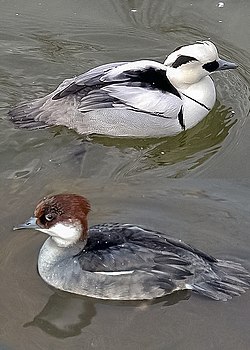Smew: Difference between revisions
No edit summary |
→References: minor formatting |
||
| Line 36: | Line 36: | ||
==References== |
==References== |
||
=== Notes === |
|||
| ⚫ | |||
{{reflist}} |
|||
=== Sources === |
|||
{{refbegin}} |
|||
| ⚫ | |||
{{refend}} |
|||
==External links== |
==External links== |
||
Revision as of 10:02, 6 June 2007
| Smew | |
|---|---|

| |
| Male (top) and female Smew | |
| Scientific classification | |
| Kingdom: | |
| Phylum: | |
| Class: | |
| Order: | |
| Family: | |
| Genus: | Mergellus Selby, 1840
|
| Species: | M. albellus
|
| Binomial name | |
| Mergellus albellus | |
| Synonyms | |
|
Mergus albellus | |
The Smew (Mergellus albellus) is a small duck which is intermediate between the mergansers and the goldeneyes, and has interbred with the Common Goldeneye. It is the only member of the genus Mergellus (Selby, 1840).
Appearance
The drake Smew, with its 'cracked ice' appearance, is unmistakable, and looks very black-and-white in flight. The females and immature males are grey birds with chestnut foreheads and crowns, and can be confused at a distance with the Ruddy Duck; they are often known as "redhead" Smew. It has oval white wing-patches in flight. The Smew's bill has a hooked tip and serrated edges, which help it catch fish when it dives for them.
Habitat

This species breeds in the northern taiga of Europe and Asia. It needs trees for breeding. The Smew lives on fish-rich lakes and slow rivers. As a migrant it leaves its breeding areas and winters on sheltered coasts or inland lakes of the Baltic Sea, the Black Sea, northern Germany and the Low Countries, with small number reaching Great Britain, mostly at regular sites. On lakes it prefers areas around the edges, often under small trees.
Behaviour
The Smew breeds in May and lays 6-9 creme-colored eggs. It nests in tree holes, such as old woodpecker nests. It is a shy bird and flushes easily when disturbed.
The Smew is one of the species to which the Agreement on the Conservation of African-Eurasian Migratory Waterbirds (AEWA) applies.
References
Notes
Sources
- Template:IUCN2006, Database entry includes justification for why this species is of least concern
External links
- Smew videos on the Internet Bird Collection
